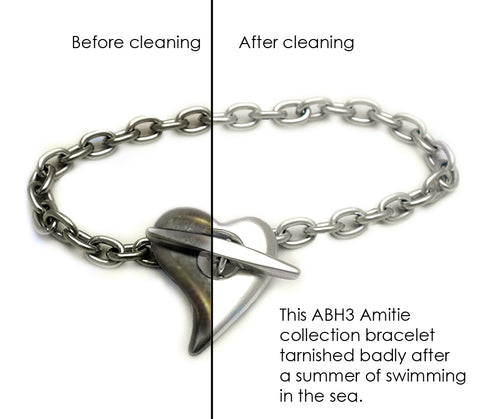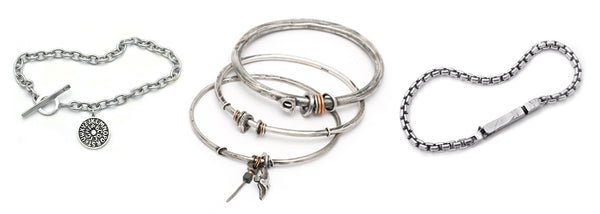
The reasons for tarnish and how to care for your silver.
One of the things we love about sterling silver is the natural patina that a well-loved piece gradually acquires; a soft, grey, lustrous ‘living finish'.
This gorgeously dark effect builds in the nooks and crannies of a piece giving the design a more dramatic depth… An effect that we love to make use of, and intentionally create at Annika Rutlin Jewellery in various designs such as the Missing U, Raven or Ixion Collections.
Firstly, let’s look at reasons for silver tarnishing and some simple tips to avoid it.
Why does jewellery tarnish?
Sterling silver is 92.5% pure silver alloyed with 7.5% of other metals, added to harden the silver and make it more durable. It's these alloys (notably copper) that oxidise in the air resulting in a tarnished outer layer on the silver. This is a chemical reaction that is thankfully usually fairly easy to remove.

Causes of tarnishing
Silver tarnish consists mainly of silver sulphide (AG2S) and some silver oxide (AG 20), which develop when the object is in a humid atmosphere, and where even a low concentration of hydrogen sulphide (H2S) exists, as well as acids and dust.
The rate of tarnish increases with the relative increase in humidity and rise in atmospheric temperature. Under such conditions, these substances interact, the atmospheric gas diffusing inward through the developing film, which causes the thickness of the layer of tarnish to grow. In time, the film develops a series of interference oxide colours before finally turning black, which is its normal colour on silver.
You'll be happy to hear that tarnish is not generally a reflection of the quality of the jewellery or the care you take of it. It is simply a reaction to external forces, most notably the air around us!!!
A Simplified Why?
Moisture, humidity and sulphur compounds!
This is why discolouration is a fairly common complaint in hot, humid environments. Perhaps you have experienced this when you have worn your jewellery on holiday?
It also explains why some people's jewellery is affected more than others, particularly those who have greater degree of moisture or acidity in their skin.
I personally regularly experience this on the build up to a trade fair…rushing around, little or no sleep and bad irregular eating habits during these hectic periods mean I literally turn my rings black.
Sulphur compounds from heavily polluted environments, oils and even food tarnish metals. It might be worth considering this when you are preparing foods such as eggs, onions, fish or shellfish.
Harsh chemicals found in make up and cleaning products can also adversely affect the look of your jewellery… sounds like an excellent excuse to get out of the housework to me!
Hairsprays, body lotions and perfumes are often the cause of tarnish so you might want to think about putting your jewellery on after you have applied these, once they have had a chance to dry or sink in to your skin.
The great news is that your skin contains natural oils that can actually help to clean your jewellery and often tarnish will subdue with continued wear. Solid silver jewellery is usually pretty easy to clean and maintain, meaning that well-made jewellery can bring long lasting joy for generations.
If you want to avoid tarnish follow the tips below:
Do:
- Immediately wipe off (rinse and dry) liquids, moisture, make up and chemicals from your jewellery
- Buff your jewellery clean with a polish impregnated cloth such as those made by Goddards or Town Talk
- Limit the amount of oxygen reaching stored jewellery by storing your jewellery in airtight containers or bags
- Place anti-tarnish papers in your jewellery box, or save up and recycle those little packets of silica gel that are found in all sorts of products (Silica gel is a desiccant so it adsorbs and holds water vapour)
Avoid:
- wearing your jewellery in shower, swimming pool, sauna or the sea
- wearing your jewellery down the gym. Even if you’re not sweating your neighbour probably will be! (Plus surely you should be working harder!)
Well, you can obviously do all the above, but you might just have to be prepared to have to spend more time cleaning your jewellery if you want it to look its best.
Don’t forget that stone set or strung jewellery needs special care and can be particularly susceptible to damage by chemicals and salts found in pools and seas.
Cleaning Tips
The first port of call is a quick polish with a silver cloth; a soft polishing cloth that is impregnated with polishing compound.
Top tip: A simple clean with ammonia free dishwashing liquid and water can be surprisingly effective (but please avoid doing this with pearls)
Need something stronger?
There are commercial silver dips that you can use which are fast and effective.
One major disadvantage of this dip method is that it is indescriminate and will remove all tarnish, even in the detailed grooves, which can often remove some of the character and charm of a piece.
If you do choose this route make sure to rinse the jewellery extremely thoroughly to avoid chemical residues that might cause reactions or damage your jewellery. Call us hippies, but we also prefer to avoid the negative environmental effects of pouring these chemicals down the drain.
We therefore love the idea of steering you in the direction of making your own jewellery cleaner with the use of common simple kitchen cabinet ingredients;
Lemon juice & Olive Oil.
½ cup of lemon juice combined with a tablespoon of olive oil.
This creates an effective jewellery cleaner which can be applied with a soft cloth…just be careful not to confuse it with the salad dressing after use!
Baking Soda & Water
1 part water: 2 parts baking soda
This creates a cleaning paste which can be applied with a soft cloth or cotton buds. Remember to thoroughly rinse out any paste that gets stuck in the grooves of the piece.
Baking Soda with White Vinegar (For serious tarnish build up)
2 tablespoons baking sode: ½ cup vinegar
Soaking the jewellery in this mixture for about 2.5 hours should blast away the tarnish.
Be careful - vinegar is very acidic, so make extra sure to rinse thoroughly.
For this reason we would not recommend this procedure for strung or stone set jewellery, other than diamond and sapphire set pieces.
Finally…
Brushing your jewellery with toothpaste on a toothbrush is very effective but can be quite harsh and scratch your jewellery. We would therefore only recommend this be used on matt, scratched effect or well worn pieces.
Whichever method you take remember to (rinse and) dry your jewellery as thoroughly as possible.
We hope this information helps you.
And if all else fails – feel free to contact us and we will be happy to refinish your jewellery for you.
+44 (0)1273 583485
Looking for more jewellery advice or looking to treat yourself to something new and exciting?
We invite you to visit our website and browse our beautiful collections.




Hi Ashley – sorry for delay in reply.
Have you tried it…You will be surprised at the result.
This is because the properties of baking soda are reactant with those of vinegar…. when you mix them it creates an exothermic reaction that quickly increases the temperature of the substances. This means you can have a great cleaning session without having to worry about toxic fumes from chemicals!
Mixing a base like baking soda with an acid like vinegar is just going to neutralize. It’s like soaking it in tap water. It’s not going to do anything